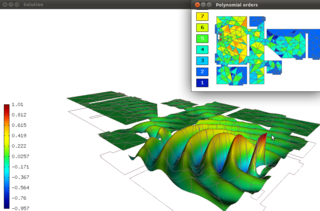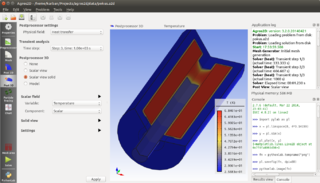Numerical methods for partial differential equations is the branch of numerical analysis that studies the numerical solution of partial differential equations (PDEs).
The boundary element method (BEM) is a numerical computational method of solving linear partial differential equations which have been formulated as integral equations, including fluid mechanics, acoustics, electromagnetics, fracture mechanics, and contact mechanics.

In the field of numerical analysis, meshfree methods are those that do not require connection between nodes of the simulation domain, i.e. a mesh, but are rather based on interaction of each node with all its neighbors. As a consequence, original extensive properties such as mass or kinetic energy are no longer assigned to mesh elements but rather to the single nodes. Meshfree methods enable the simulation of some otherwise difficult types of problems, at the cost of extra computing time and programming effort. The absence of a mesh allows Lagrangian simulations, in which the nodes can move according to the velocity field.
In the numerical solution of partial differential equations, a topic in mathematics, the spectral element method (SEM) is a formulation of the finite element method (FEM) that uses high degree piecewise polynomials as basis functions. The spectral element method was introduced in a 1984 paper by A. T. Patera. Although Patera is credited with development of the method, his work was a rediscovery of an existing method
Ivo M. Babuška is a Czech-American mathematician, noted for his studies of the finite element method and the proof of the Babuška–Lax–Milgram theorem in partial differential equations. One of the celebrated result in the finite elements is the so-called Ladyzenskaja–Babuška–Brezzi (LBB) condition, which provides sufficient conditions for a stable mixed formulation. The LBB condition has guided mathematicians and engineers to develop state-of-the-art formulations for many technologically important problems like Darcy flow, Stokes flow, incompressible Navier–Stokes, nearly incompressible elasticity.

The extended finite element method (XFEM), is a numerical technique based on the generalized finite element method (GFEM) and the partition of unity method (PUM). It extends the classical finite element method (FEM) approach by enriching the solution space for solutions to differential equations with discontinuous functions.

The finite element method (FEM) is a widely used method for numerically solving differential equations arising in engineering and mathematical modeling. Typical problem areas of interest include the traditional fields of structural analysis, heat transfer, fluid flow, mass transport, and electromagnetic potential. The FEM is a general numerical method for solving partial differential equations in two or three space variables. To solve a problem, the FEM subdivides a large system into smaller, simpler parts that are called finite elements. This is achieved by a particular space discretization in the space dimensions, which is implemented by the construction of a mesh of the object: the numerical domain for the solution, which has a finite number of points. The finite element method formulation of a boundary value problem finally results in a system of algebraic equations. The method approximates the unknown function over the domain. The simple equations that model these finite elements are then assembled into a larger system of equations that models the entire problem. The FEM then uses variational methods from the calculus of variations to approximate a solution by minimizing an associated error function.

Hermes2D is a C++/Python library of algorithms for rapid development of adaptive hp-FEM solvers. hp-FEM is a modern version of the finite element method (FEM) that is capable of extremely fast, exponential convergence.
hp-FEM is a general version of the finite element method (FEM), a numerical method for solving partial differential equations based on piecewise-polynomial approximations that employs elements of variable size (h) and polynomial degree (p). The origins of hp-FEM date back to the pioneering work of Barna A. Szabó and Ivo Babuška who discovered that the finite element method converges exponentially fast when the mesh is refined using a suitable combination of h-refinements (dividing elements into smaller ones) and p-refinements. The exponential convergence makes the method a very attractive choice compared to most other finite element methods which only converge with an algebraic rate. The exponential convergence of the hp-FEM was not only predicted theoretically but also observed by numerous independent researchers.

StressCheck is a finite element analysis software product developed and supported by ESRD, Inc. of St. Louis, Missouri. It is one of the first commercially available FEA products to utilize the p-version of the finite element method and support verification and validation in computational solid mechanics and the requirements of Simulation Governance.
Smoothed finite element methods (S-FEM) are a particular class of numerical simulation algorithms for the simulation of physical phenomena. It was developed by combining meshfree methods with the finite element method. S-FEM are applicable to solid mechanics as well as fluid dynamics problems, although so far they have mainly been applied to the former.
Weakened weak form is used in the formulation of general numerical methods based on meshfree methods and/or finite element method settings. These numerical methods are applicable to solid mechanics as well as fluid dynamics problems.
In numerical mathematics, the boundary knot method (BKM) is proposed as an alternative boundary-type meshfree distance function collocation scheme.
The Kansa method is a computer method used to solve partial differential equations. Partial differential equations are mathematical models of things like stresses in a car's body, air flow around a wing, the shock wave in front of a supersonic airplane, quantum mechanical model of an atom, ocean waves, socio-economic models, digital image processing etc. The computer takes the known quantities such as pressure, temperature, air velocity, stress, and then uses the laws of physics to figure out what the rest of the quantities should be like a puzzle being fit together. Then, for example, the stresses in various parts of a car can be determined when that car hits a bump at 70 miles per hour.
Fluid motion is governed by the Navier–Stokes equations, a set of coupled and nonlinear partial differential equations derived from the basic laws of conservation of mass, momentum and energy. The unknowns are usually the flow velocity, the pressure and density and temperature. The analytical solution of this equation is impossible hence scientists resort to laboratory experiments in such situations. The answers delivered are, however, usually qualitatively different since dynamical and geometric similitude are difficult to enforce simultaneously between the lab experiment and the prototype. Furthermore, the design and construction of these experiments can be difficult, particularly for stratified rotating flows. Computational fluid dynamics (CFD) is an additional tool in the arsenal of scientists. In its early days CFD was often controversial, as it involved additional approximation to the governing equations and raised additional (legitimate) issues. Nowadays CFD is an established discipline alongside theoretical and experimental methods. This position is in large part due to the exponential growth of computer power which has allowed us to tackle ever larger and more complex problems.

GetFEM++ is a generic finite element C++ library with interfaces for Python, Matlab and Scilab. It aims at providing finite element methods and elementary matrix computations for solving linear and non-linear problems numerically. Its flexibility in choosing among different finite element approximations and numerical integration methods is one of its distinguishing characteristics.

Agros2D is an open-source code for numerical solutions of 2D coupled problems in technical disciplines. Its principal part is a user interface serving for complete preprocessing and postprocessing of the tasks. The processor is based on the library Hermes containing the most advanced numerical algorithms for monolithic and fully adaptive solution of systems of generally nonlinear and nonstationary partial differential equations (PDEs) based on hp-FEM. Both parts of the code are written in C++.
Christoph Schwab is a German applied mathematician, specializing in numerical analysis of partial differential equations and boundary integral equations.

Barna A. Szabó is a Hungarian-American engineer and educator, noted for his contributions on the finite element method, particularly the conception and implementation of the p- and hp-versions of the Finite Element Method. He is a founding member and fellow of the United States Association for Computational Mechanics, an external member of the Hungarian Academy of Sciences and fellow of the St. Louis Academy of Sciences.









